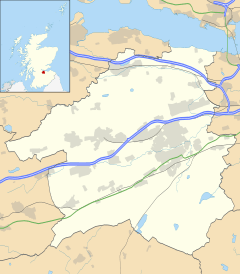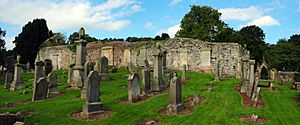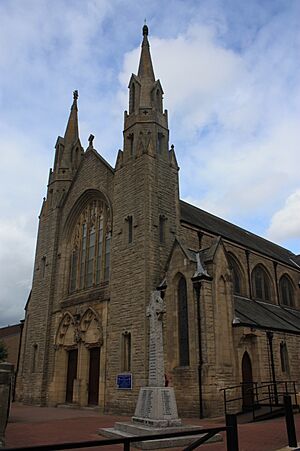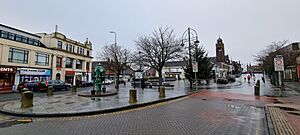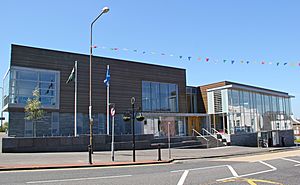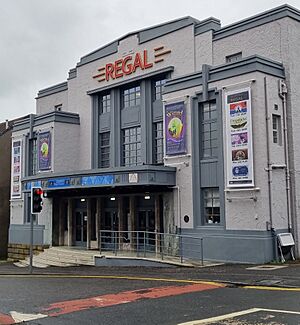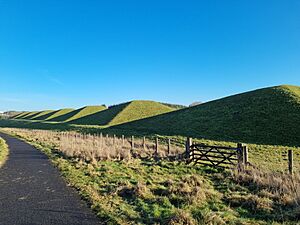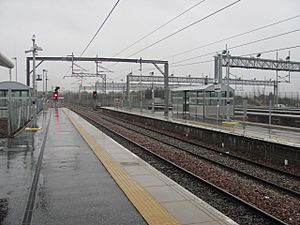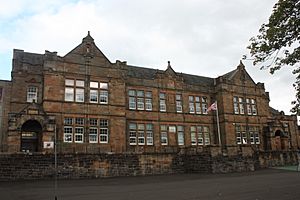Bathgate facts for kids
Quick facts for kids Bathgate
|
|
|---|---|
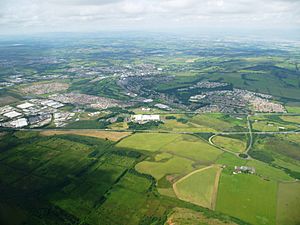 View of Bathgate, West Lothian from an aeroplane approaching Edinburgh Airport |
|
| Population | 23,600 (2020) |
| OS grid reference | NS973689 |
| • Edinburgh | 18 mi (29 km) |
| • London | 336 mi (541 km) |
| Council area | |
| Lieutenancy area |
|
| Country | Scotland |
| Sovereign state | United Kingdom |
| Post town | BATHGATE |
| Postcode district | EH47, EH48 |
| Dialling code | 01506 |
| Police | Lothian and Borders |
| Fire | Lothian and Borders |
| Ambulance | Scottish |
| EU Parliament | Scotland |
| UK Parliament |
|
| Scottish Parliament |
|
Bathgate (also known as Scots: Bathket or Bathkit in Scots, and Scottish Gaelic: Both Chèit in Scottish Gaelic) is a town in West Lothian, Scotland. It is about 5 miles (8 km) west of Livingston and right next to the M8 motorway. Other towns nearby include Linlithgow, Livingston, and West Calder. Several villages are also considered part of the Bathgate area, such as Blackburn, Whitburn, Stoneyburn, Armadale, Torphichen, and Fauldhouse.
People have lived in the Bathgate area since about 3500 BC. This is because the ancient Neolithic burial site at Cairnpapple Hill is only 2 miles (3 km) south of the town. The world's oldest known reptile fossil was even found here! By the 12th century, Bathgate was a small village with a church and a castle. Mines started in the 1600s, but the town stayed small until the Industrial Revolution. In the Victorian era, Bathgate became important for mining, especially for coal and shale oil.
By the early 1900s, most of the mining and heavy industries closed down. Bathgate then focused on making things like vehicles and electronics. However, these factories also closed in the late 20th century. Today, Bathgate is the second largest town in West Lothian, after Livingston. Many people who live here travel to work in other parts of Scotland's Central Belt.
Contents
Discovering Bathgate's Past
Early History (1100s–1500s)
Bathgate first appears in history around 1160. King Malcolm IV of Scotland mentioned it in a special document. Over the years, the town's name was spelled in different ways, like Bathchet, Bathket, and Bathgetum. The name probably comes from an old language word meaning 'Boar Wood'.
Around 1160, King Malcolm IV sent two important people, Uchtred Dalrymple and Geoffrey de Melville, to Bathgate. They measured out the land for what would become Bathgate Parish. The church and its land were given to Holyrood Abbey at that time.
In 1315, Marjorie Bruce, the daughter of King Robert The Bruce of Scotland, married Walter Stewart. As a wedding gift, she received the lands and castle of Bathgate. Walter Stewart died at the castle in 1326. This marriage is still celebrated today with an annual event called the Bathgate Procession & John Newland Festival.
Not much of the old castle remains today. People have found old kitchen tools and simple stone coffins in the area where it once stood.
The remains of Bathgate's old parish church can still be seen at Kirkton. The first church was built in the 1100s. A new church was built on the same spot in 1739. This simple white church was used until 1882.
Life in the 1600s and 1700s
In 1606, a coal miner named Sandy Maund found silver ore near Hilderston, close to Cairnpapple Hill. This led to a short-lived silver mining project by King James VI of Scotland. The mine was called "God's Blessing." However, the silver quality varied, and by 1613, mining stopped.
Bathgate stayed a small farming community for a long time. In the 1600s, a group called the Covenanters, who were against the King's religious rules, passed through Bathgate. They had a difficult night there in November 1666, facing freezing weather as they marched towards the Pentland Hills.
Growing in the 1800s
Around 1800, the Glenmavis Distillery opened in Bathgate, making whisky. It closed in 1910.
In 1831, Bathgate Academy was built. This important building was designed by architects R & R Dickson. It was paid for by John Newlands, a rich plantation owner from Jamaica. The building later became part of Balbardie Primary School and is now private homes.
When the Edinburgh and Bathgate Railway opened in 1849, local mines and quarries were busy digging up coal, lime, and ironstone.
A big change came in 1852 when James Young discovered a special type of coal called cannel coal. He opened the Bathgate Chemical Works, which was the world's first factory to make paraffin oil and paraffin wax. This marked the end of Bathgate as just a farming town. When the cannel coal ran out around 1866, Young started making paraffin from oil shale, which was easier to find. You can still see orange hills of waste material, called bings, from this time across the Lothians. Coal mines, quarries, and related factories were the main jobs in Bathgate by the end of the 1800s.
Between 1882 and 1884, Bathgate High Parish Church was built. It was made of sandstone in a Romanesque style.
Bathgate in the 1900s
In 1904, St David's Church was built in Bathgate. It has a bell tower like those in northern Italy. This church is now the local Bathgate cinema. A few years later, in 1908, St Mary's Roman Catholic Church was built in a Gothic style.
In the middle of the 20th century, many local factories closed. To help, the British government offered money to companies that moved to West Lothian. Because of this, in 1961, a big car company called BMC (which made Austin and Morris cars) opened a new factory in Bathgate. This factory made trucks and tractors. It closed in 1986.
Good news for travelers! On March 24, 1986, the Bathgate-Edinburgh railway line reopened for passengers. It had been closed since the 1950s. This railway line was later extended to Airdrie in 2010. Now, trains can run between Glasgow Queen Street and Edinburgh Waverley through Bathgate.
A very important discovery happened in Bathgate in 1987. The world's oldest known reptile fossil, called Westlothiana lizziae (or Lizzie), was found at East Kirkton Quarry. It is now in the Museum of Scotland.
In 1992, a US company called Motorola opened a mobile phone factory in Bathgate. But in 2001, the demand for mobile phones dropped. Motorola closed the factory, and over 3,000 jobs were lost. The large site is now called the Pyramids Business Park. In 2021 and 2022, it was used as a main COVID-19 vaccine center. In 2021, it was announced that the Pyramids Business Park would become a new film and TV studio. Movies like T2 Trainspotting and TV shows like Good Omens (starring local actor David Tennant) have been filmed there.
How Many People Live Here?
| Year | 1861 | 1871 | 1881 | 1891 | 1901 | 1911 | 1921 | 1941 | 1951 | 1961 | 1971 | 1981 | 1991 | 2001 | 2011 |
|---|---|---|---|---|---|---|---|---|---|---|---|---|---|---|---|
| Population | 4,827 | 4,991 | 6,425 | 5,786 | 7,549 | 8,226 | 8,504 | 10,127 | 11,291 | not available | not available | not available | 13,819 | 15,068 | 20,363 |
| Sources:Online Historical Population Reports, A Vision Of Britain Through Time, General Register Office for Scotland and http://www.scotlandscensus.gov.uk/ | |||||||||||||||
What is Bathgate Like Today?
Shopping in Bathgate
Bathgate has many well-known shops. In the late 1800s, the co-operative halls were built. They had a bakery, butchery, grocery store, and sold clothing and furniture. They even had a dance hall! These halls served the community until the 1980s.
Fun and Culture
Bathgate Procession and Community Festival
John Newland was an important person who helped Bathgate a lot. He moved to the West Indies and became very rich. He used his money to help build Bathgate Academy in 1833. For a long time, the town held an annual event called the Procession or Newland's Day to remember him. However, in 2020, the name was changed to the 'Bathgate Procession and Community Festival'. This change happened because John Newland had made his money from the slave trade, and the community wanted a name that better reflected everyone.
Theatre and Cinema
The Regal is a community theatre in Bathgate. It was built in 1938 as a cinema and later updated in 1995. It has a cool Art Deco style.
The local cinema, Bathgate Cinema, which was in the old St David's Church building, closed in April 2024.
Town Square and Fountain
The main town square in Bathgate is called the Steelyard, next to George Place. In the Steelyard, you'll find the McLagan Fountain. This fountain was put up in 1878 with help from the wife of a local politician, Peter McLagan.
Bennie Museum
The Bennie Museum is a local museum run by volunteers. It opened in 1989. The museum shows items from Bathgate's history and has exhibits about what childhood was like in the past. It is located in old cottages that were built between the late 1700s and mid-1800s.
Outdoor Art
You might notice some interesting land art around Bathgate. The 'Sawtooth Ramps' project, also known as the Pyramids, was built in 1993. It's 300-metre (980 ft) long and has seven 11-metre (36 ft) high ramps. The artist, Patricia Leighton, designed it to look like local hills and the old mining waste heaps. The pyramid shape gave the nearby Pyramids Business Park its name. In 2007, a farmer even painted the sheep grazing on the pyramids bright red!
In 1998, another artist, Lumir Soukup, created an earth sculpture called The Bathgate Face. He measured the faces of over 1200 Bathgate residents to create an 'average profile' for his sculpture. When new buildings were planned in 2004, the artist convinced the builders to work around his art instead of destroying it.
Music
Bathgate was home to the rock band Goodbye Mr Mackenzie in the 1980s and 1990s. They became famous after studying music at the local college.
Getting Around Bathgate
Roads
Bathgate is easy to reach from the M8 motorway using Junctions 3A and 4. This road connects the town to Edinburgh, Glasgow, and other towns. The A801 road also links Bathgate to the M9 motorway.
Buses
Bus services in Bathgate are run by companies like Lothian Country Buses, SD Travel, and E&M Horsburgh. You can find frequent buses to many nearby towns and to Edinburgh.
Some of the main bus routes are:
- 73 - Livingston - St. John's Hospital - Boghall - Bathgate - Wester Inch - Blackburn
- X18 - Edinburgh - Corstorphine - Broxburn - Bathgate - Armadale - Whitburn
- X27 - Edinburgh - Sighthill - Calderwood - East Calder - Livingston - Bathgate
- X28 - Edinburgh - Sighthill - Kirknewton - East Calder - Livingston - Bathgate
- N18 - Edinburgh - Corstorphine - Broxburn - Bathgate (Weekend Night Service)
- N28 - Edinburgh - Kirknewton - Calderwood - East Calder - Livingston - Bathgate (Night Service)
Trains
Bathgate Railway Station is operated by Scotrail. You can catch trains heading east to Edinburgh Waverley or west to Glasgow and beyond.
Air Travel
Edinburgh Airport is only about 13 miles (21 km) away from Bathgate.
Learning in Bathgate
Bathgate has two secondary schools: Bathgate Academy and St Kentigern's Academy. The primary schools in Bathgate are Balbardie, St Mary's, Boghall, St Columba's, Windyknowe, and Simpson Primary. Simpson Primary opened in 2007 and is named after James Young Simpson.
Sports in Bathgate
Football
Bathgate is home to the football club Bathgate Thistle. They won the Scottish Junior Cup in 2008! They play at Creamery Park.
An older football club, Bathgate F.C., played in the town between 1893 and 1938.
Motorsport
Several famous racing drivers grew up in Bathgate. Paul di Resta is a former Formula One driver. He now races touring cars for Mercedes. He is cousins with two other well-known drivers: Dario Franchitti, who won many IndyCar championships, and his younger brother Marino, who races sports cars.
Famous People from Bathgate
Many notable people have connections to Bathgate, including:
- David Tennant – a famous actor (born in Bathgate, raised in Paisley)
- James Young Simpson – discovered that chloroform could be used as an anaesthetic
- Richard Bladworth Angus – a Scottish-Canadian banker who helped start the Canadian Pacific Railway
- Fern Brady – a comedian and writer
- Lewis Capaldi – a popular singer-songwriter
- Isla Fisher – an actress (lived here as a young child)
- Dario Franchitti – a champion racing driver
- Marino Franchitti – a racing driver, Dario's brother
- Bernard Gallacher – a professional golfer
- Stephen Gallacher – a professional golfer, Bernard's nephew
- Goodbye Mr Mackenzie – an indie rock band
Partner Towns
Bathgate is partnered with:
- Cran-Gevrier, France
And as part of West Lothian, it is also partnered with:
- Hochsauerland, Germany
See also
 In Spanish: Bathgate para niños
In Spanish: Bathgate para niños


